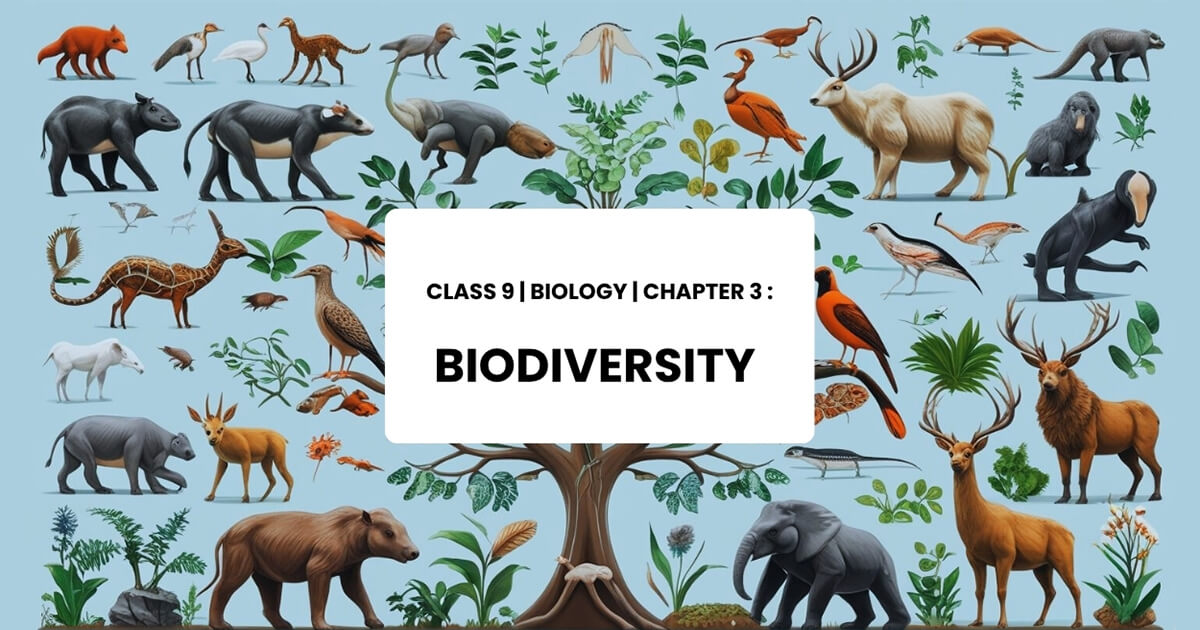Biodiversity, the third chapter of Class 9 Biology, highlights the incredible variety of life on Earth and how scientists classify living organisms. This post features a carefully selected set of MCQs designed to help students understand biological classification systems, characteristics of the five kingdoms, and the significance of biodiversity in nature. The questions include topics such as scientific naming, classification levels, and major features of organisms from each kingdom.
1. What does the term biodiversity refer to?
- A. Number of species in one kingdom
- B. Variety of life forms in an ecosystem ✅
- C. Only plants and animals
- D. Only microorganisms
Explanation: Biodiversity means the variety of all living organisms in a specific area or the entire planet.
2. Which scientist introduced the system of binomial nomenclature?
- A. Darwin
- B. Aristotle
- C. Carolus Linnaeus ✅
- D. Pasteur
Explanation: Linnaeus developed the binomial system of naming organisms using genus and species.
3. In binomial nomenclature, the first part of the name indicates:
- A. Species
- B. Genus ✅
- C. Family
- D. Class
Explanation: In scientific names, the first word is the genus, which is always capitalized.
4. Which kingdom includes bacteria?
- A. Protista
- B. Fungi
- C. Monera ✅
- D. Plantae
Explanation: Kingdom Monera includes unicellular prokaryotic organisms such as bacteria.
5. Which organism belongs to the kingdom Protista?
- A. Mushroom
- B. Paramecium ✅
- C. Yeast
- D. Bacteria
Explanation: Paramecium is a unicellular eukaryotic organism found in water, classified under Protista.
6. Which kingdom includes multicellular organisms that absorb food from surroundings?
- A. Fungi ✅
- B. Plantae
- C. Protista
- D. Animalia
Explanation: Fungi obtain food through absorption and do not perform photosynthesis.
7. Which of these is a feature of kingdom Plantae?
- A. Heterotrophic nutrition
- B. Photosynthesis ✅
- C. Lack of cell wall
- D. Movement
Explanation: Plants are autotrophic and produce food through photosynthesis.
8. Animals differ from plants because they:
- A. Make their own food
- B. Lack cell walls ✅
- C. Are stationary
- D. Are multicellular
Explanation: Animal cells do not have cell walls and animals are heterotrophic.
9. The purpose of classification is to:
- A. Confuse learners
- B. Create new organisms
- C. Organize living things based on similarities ✅
- D. Increase biodiversity
Explanation: Classification helps group organisms to study them more easily.
10. Which one of these organisms belongs to kingdom Fungi?
- A. Algae
- B. Mushroom ✅
- C. Paramecium
- D. Bacteria
Explanation: Mushrooms are multicellular fungi that feed by absorption.
11. Which level of classification comes directly below class?
- A. Phylum
- B. Order
- C. Family ✅
- D. Genus
Explanation: The correct order of classification is: Kingdom, Phylum, Class, Order, Family, Genus, Species.
12. In scientific naming, which part is always written in lowercase?
- A. Genus
- B. Species ✅
- C. Family
- D. Order
Explanation: In binomial nomenclature, the genus is capitalized and the species is written in lowercase.
13. Which of the following is NOT included in the five-kingdom classification?
- A. Monera
- B. Protista
- C. Virus ✅
- D. Fungi
Explanation: Viruses are not included in the five-kingdom classification as they are considered non-living outside a host.
14. The kingdom with organisms having no nucleus is:
- A. Protista
- B. Plantae
- C. Monera ✅
- D. Fungi
Explanation: Monera includes prokaryotes like bacteria that lack a true nucleus.
15. Multicellular, non-green, and heterotrophic organisms are found in:
- A. Plantae
- B. Protista
- C. Fungi ✅
- D. Animalia
Explanation: Fungi are multicellular (except yeast), heterotrophic, and lack chlorophyll.
16. Which of the following is an autotrophic protist?
- A. Euglena ✅
- B. Mushroom
- C. Amoeba
- D. Yeast
Explanation: Euglena is a protist that can make its own food using sunlight (photosynthesis).
17. Which kingdom includes organisms that are mostly unicellular and eukaryotic?
- A. Monera
- B. Fungi
- C. Protista ✅
- D. Plantae
Explanation: Protists are primarily unicellular eukaryotes like Amoeba and Paramecium.

